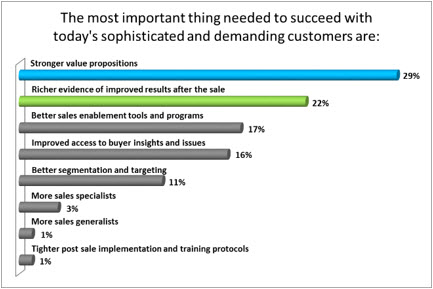Value Propositions That Anticipate Customers’ Needs

At Alexander Group’s recent Chief Sales Executive Forum, revenue leaders noted a key concern: When asked, “What is the most important thing needed to succeed with today’s sophisticated and demanding customers?” respondents in the audience overwhelmingly selected “Stronger Value Propositions” and “Richer Evidence of Results.” These two components outpaced all of the more traditional investment areas. In today’s world, value matters. But how do manufacturing organizations successfully deliver impactful messages that sellers can easily communicate?
Too often, manufacturing organizations perpetuate a dysfunctional, siloed relationship between the sales, marketing and service functions. They fail to deliver impactful messages that sellers—particularly less experienced sellers–can easily communicate. Alexander Group (AGI) helps revenue leaders recognize the link between marketing, sales and service as a vital connection ensuring that value propositions resonate with customers’ needs.
World-class manufacturers create winning value propositions by first tailoring to each unique customer segment with a unique set of value propositions. In order to ensure that all value messages resonate, winning organizations create value propositions that meet four simple criteria:
- Compelling – Value propositions cannot be defined by brand or feature benefit. Rather, they must motivate the receiver of the message to act. Compelling value props are highly tailored to both buyers and influencers. Interestingly, compelling value propositions may not always evoke an action to sell, but to encourage the next step in the sale process. Agreeing to conducting a trial or participating in a new product demo are completely acceptable outcomes.
- Differentiated – Winning messages reveal what sets your products or services apart from the competition. Sellers need unique messages depending on the competitive landscape. Ensuring that they know your best attributes in comparison to the rival at hand will produce results.
- Observable – Savvy buyers already know what the product should do. They do not always know by how much, how fast, how efficient or how your offering stacks up when the numbers are crunched. Winning messages always include data and observable differences to provide anticipated results-based outcomes.
- Clear – Most importantly, value propositions must be easy to (a) understand (b) communicate and (c) align to the right audience. World-class organizations direct their sellers as to how to deliver the right insights to the right audience at the right time. (Sellers to be great actors; they should not have to write their own plays.)
Finally, in order to create value propositions that meet these four criteria, the sales, marketing and service departments must coordinate efforts to gather Voice of Customer (VOC) insights. VP of Sales, Chief Marketing Officers and those responsible for service should consider:
- Have we listened to our VOC?
- Do our value propositions differentiate for each buyer type?
- Does our team believe that? Can they deliver them?
Learn more about the Alexander Group’s Manufacturing practice or contact us to understand how AGI can help you assess and enhance the strength of your value propositions.
